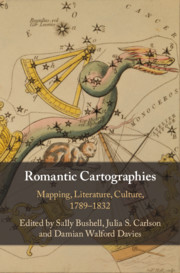51 results
Chapter 10 - Unmapping John Clare
- from Part III - Beyond Romantic Cartographies
-
-
- Book:
- Romantic Cartographies
- Published online:
- 15 January 2021
- Print publication:
- 10 December 2020, pp 232-251
-
- Chapter
- Export citation
Bibliography
-
- Book:
- Romantic Cartographies
- Published online:
- 15 January 2021
- Print publication:
- 10 December 2020, pp 292-315
-
- Chapter
- Export citation
Illustrations
-
- Book:
- Romantic Cartographies
- Published online:
- 15 January 2021
- Print publication:
- 10 December 2020, pp vii-x
-
- Chapter
- Export citation
Notes on Contributors
-
- Book:
- Romantic Cartographies
- Published online:
- 15 January 2021
- Print publication:
- 10 December 2020, pp xi-xvi
-
- Chapter
- Export citation
Part I - Romantic Maps, Romantic Mapping
-
- Book:
- Romantic Cartographies
- Published online:
- 15 January 2021
- Print publication:
- 10 December 2020, pp 25-126
-
- Chapter
- Export citation
Part III - Beyond Romantic Cartographies
-
- Book:
- Romantic Cartographies
- Published online:
- 15 January 2021
- Print publication:
- 10 December 2020, pp 209-291
-
- Chapter
- Export citation
Acknowledgements
-
- Book:
- Romantic Cartographies
- Published online:
- 15 January 2021
- Print publication:
- 10 December 2020, pp xix-xx
-
- Chapter
- Export citation
Copyright page
-
- Book:
- Romantic Cartographies
- Published online:
- 15 January 2021
- Print publication:
- 10 December 2020, pp iv-iv
-
- Chapter
- Export citation
Preface
-
- Book:
- Romantic Cartographies
- Published online:
- 15 January 2021
- Print publication:
- 10 December 2020, pp xvii-xviii
-
- Chapter
- Export citation
Index
-
- Book:
- Romantic Cartographies
- Published online:
- 15 January 2021
- Print publication:
- 10 December 2020, pp 316-330
-
- Chapter
- Export citation

Romantic Cartographies
- Mapping, Literature, Culture, 1789–1832
-
- Published online:
- 15 January 2021
- Print publication:
- 10 December 2020
Part II - Cartographic Encounters
-
- Book:
- Romantic Cartographies
- Published online:
- 15 January 2021
- Print publication:
- 10 December 2020, pp 127-208
-
- Chapter
- Export citation
Contents
-
- Book:
- Romantic Cartographies
- Published online:
- 15 January 2021
- Print publication:
- 10 December 2020, pp v-vi
-
- Chapter
- Export citation
Introduction - Romantic Cartographies
-
-
- Book:
- Romantic Cartographies
- Published online:
- 15 January 2021
- Print publication:
- 10 December 2020, pp 1-24
-
- Chapter
- Export citation
Contents
-
- Book:
- Reading and Mapping Fiction
- Published online:
- 11 June 2020
- Print publication:
- 02 July 2020, pp vii-viii
-
- Chapter
- Export citation
1 - A Shifting Relationship: From Literary Geography to Critical Literary Mapping
-
- Book:
- Reading and Mapping Fiction
- Published online:
- 11 June 2020
- Print publication:
- 02 July 2020, pp 16-43
-
- Chapter
- Export citation
Acknowledgement of Prior Publications
-
- Book:
- Reading and Mapping Fiction
- Published online:
- 11 June 2020
- Print publication:
- 02 July 2020, pp xiv-xiv
-
- Chapter
- Export citation
4 - Mapping Murder
-
- Book:
- Reading and Mapping Fiction
- Published online:
- 11 June 2020
- Print publication:
- 02 July 2020, pp 127-163
-
- Chapter
- Export citation
7 - Fearing the Map: Representational Priorities and Referential Assumptions
-
- Book:
- Reading and Mapping Fiction
- Published online:
- 11 June 2020
- Print publication:
- 02 July 2020, pp 237-272
-
- Chapter
- Export citation
Acknowledgements
-
- Book:
- Reading and Mapping Fiction
- Published online:
- 11 June 2020
- Print publication:
- 02 July 2020, pp xv-xvi
-
- Chapter
- Export citation



